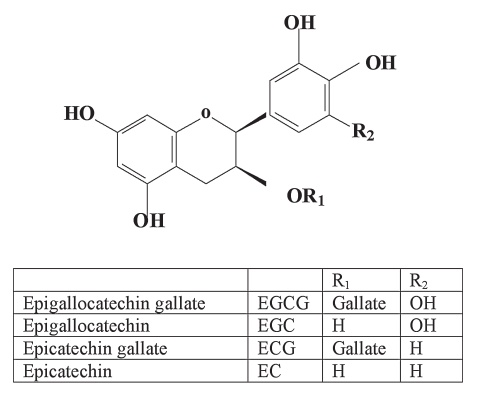Tea is a decoction of the Camellia sinensis leaf. Tea comes in a number of different forms including green tea, oolong tea and black tea, with the degree of fermentation during processing determining the final product. Fermentation can alter the chemical composition of the leaves. Green tea is not fermented at all, but instead the leaves are steamed and dried. This produces a tea that maintains the original phytonutrient content of the tea plant. Tea leaves contain high concentrations of polyphenols called catechins, and green tea is therefore a good source of these polyphenols. Catechins, also called flavan-3-ols, are a group of pytonutrients that belong to the flavonoid group of polyphenols. Catechins are bioavailable in humans where they may have beneficial antioxidant effects, and this explains the protective effects of catechins against diseases such as cardiovascular disease. However, catechins may have other effects, and in particular may be able to induce weight loss in those that consume them regularly.
The weight loss effects of green tea are well reported and this effect has been suggested to be as a result of the catechins contained within green tea leaves. A number of hypotheses have been suggested to account for the weight loss effects of green tea and these tend to centre on the presence of caffeine and catechins in the leaves. Just how catechins cause weight loss is not fully understood. One hypothesis suggests that polyphenols including catechins may inhibit starch digesting enzymes, and thus provide beneficial glycaemic effects which in turn improve insulin sensitivity. Alternatively, the antioxidant effects of the catechins may improve insulin sensitivity through a direct protective effect on the insulin receptor. However, it has also been suggested that catechins may have direct thermogenic effects. In particular, the catechin epigallocatechin gallate may perpetuate the effects of catecholamines (adrenaline and noradrenaline) through inhibition of the main degradation enzymes involved in their metabolism.
By inhibiting the main degrading enzyme of catecholamines, catechins maintain adrenaline levels in the blood. This explains the ability of green tea to increase the blunted thermic effect of food seen in obese individual. Green tea contains about 10-15 % epigallocatechin gallate, 6-10 % epigallocatechin, 2-3 % epicatechin gallate and 2 % epicatechin (figure 1), although is thought that the epigallocatechin gallate shows the best thermogenic activity. A green tea infusion contain around 30 % catechins, whereas black tea, which has been extensively fermented contains only around 9 % catechins. Therefore although green tea is a superior source of catechins, black tea does contain high amounts of catechins relative to other foods. This may explain the weight loss effects of black tea that have also been reported in the nutritional literature. The weight loss effects of both green and black tea may explain the beneficial cardioprotective effects of tea, as weight gain is a major risk factor for cardiovascular disease.
RdB

